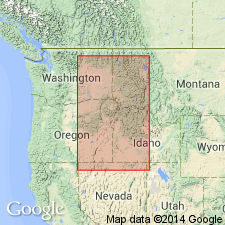
- Usage in publication:
-
- Chicken Creek Formation
- Modifications:
-
- Original reference
- Dominant lithology:
-
- Ash
- AAPG geologic province:
-
- Great Basin province
Summary:
Pg. 497-506 (Discussion of potassium-argon K-Ar ages of some western Tertiary floras). Sample of Chicken Creek Formation is from 2-foot bed of biotite rhyolite ash 5 feet above uppermost of the 10 florules that comprise Bull Run flora. Radiometric age of 35.2 +/-1 Ma (K-Ar method on biotite) indicates this florule is earliest Chadronian [early Oligocene] or transitional Eocene/Oligocene and florules stratigraphically below it are Duchesnean, or latest Eocene. Name taken from Axelrod manuscript.
[Type locality not stated.] Notable exposures 30 yards north of junction of Highway 11 and road to Cornucopia mining district, in NE/4 sec. 11, T. 42 N., R. 52 E., Bull Run 15-min quadrangle, Elko Co., northeastern NV.
Source: US geologic names lexicon (USGS 1350, p. 148); supplemental information from GNU records (USGS DDS-6; Menlo GNULEX).
For more information, please contact Nancy Stamm, Geologic Names Committee Secretary.
Asterisk (*) indicates published by U.S. Geological Survey authors.
"No current usage" (†) implies that a name has been abandoned or has fallen into disuse. Former usage and, if known, replacement name given in parentheses ( ).
Slash (/) indicates name conflicts with nomenclatural guidelines (CSN, 1933; ACSN, 1961, 1970; NACSN, 1983, 2005, 2021). May be explained within brackets ([ ]).

